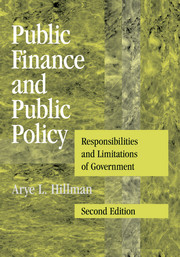Book contents
- Frontmatter
- Contents
- Preface to the Second Edition
- 1 MARKETS AND GOVERNMENTS
- 2 INSTITUTIONS AND GOVERNANCE
- 3 PUBLIC GOODS
- 4 PUBLIC FINANCE FOR PUBLIC GOODS
- 5 MARKET CORRECTIONS
- 6 VOTING
- 7 SOCIAL JUSTICE
- 8 ENTITLEMENTS
- 9 CHOICE OF TAXATION
- 10 THE NEED FOR GOVERNMENT
- TOPICS FOR DISCUSSION
- Author Index
- Subject Index
- References
3 - PUBLIC GOODS
- Frontmatter
- Contents
- Preface to the Second Edition
- 1 MARKETS AND GOVERNMENTS
- 2 INSTITUTIONS AND GOVERNANCE
- 3 PUBLIC GOODS
- 4 PUBLIC FINANCE FOR PUBLIC GOODS
- 5 MARKET CORRECTIONS
- 6 VOTING
- 7 SOCIAL JUSTICE
- 8 ENTITLEMENTS
- 9 CHOICE OF TAXATION
- 10 THE NEED FOR GOVERNMENT
- TOPICS FOR DISCUSSION
- Author Index
- Subject Index
- References
Summary
Chapter 1 showed how competitive markets achieve efficiency for private goods – or goods that benefit one person. We also noted that for public goods, which can benefit many people simultaneously, we do not expect markets to result in efficient supply of public goods because people can benefit when others pay. In chapter 1, we also encountered an example of a public good in the rule of law. In this chapter, we investigate public goods in detail.
Because many people benefit simultaneously, public goods could well be called collective goods. The collective benefit suggests a need for collective decisions. Public goods thereby provide a foundation for a “theory of the state,” through the need for institutions of government that allow collective decisions to be made.
The need for government is, however, subject to the characteristics of institutions: we saw in chapter 2 that political and bureaucratic principal–agent problems impose limitations on delegating responsibilities to governments.
In this chapter, we shall for the most part set aside the limitations of political and bureaucratic principal–agent problems. We shall ask normative questions about the desirable role of government as if political decision makers and bureaucrats could always be assured to be the faithful agents of taxpayers and voters. The questions that we ask are, therefore, about what political and bureaucratic decision makers who faithfully seek the public interest should do – or can do – to ensure availability of public goods.
- Type
- Chapter
- Information
- Public Finance and Public PolicyResponsibilities and Limitations of Government, pp. 135 - 242Publisher: Cambridge University PressPrint publication year: 2009



